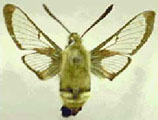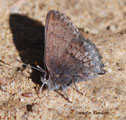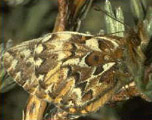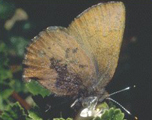Native Plants
Search for native plants by scientific name, common name or family. If you are not sure what you are looking for, try the Combination Search or our Recommended Species lists.
Arctostaphylos uva-ursi
Arctostaphylos uva-ursi (L.) Spreng.
Kinnikinnick, Red Bearberry, Kinnikinnik
Ericaceae (Heath Family)
Synonym(s): Arctostaphylos adenotricha, Arctostaphylos uva-ursi ssp. adenotricha, Arctostaphylos uva-ursi ssp. coactilis, Arctostaphylos uva-ursi ssp. longipilosa, Arctostaphylos uva-ursi ssp. monoensis, Arctostaphylos uva-ursi ssp. stipitata, Arctostaphylos uva-ursi var. adenotricha, Arctostaphylos uva-ursi var. coactilis, Arctostaphylos uva-ursi var. leobreweri, Arctostaphylos uva-ursi var. marinensis, Arctostaphylos uva-ursi var. pacifica, Arctostaphylos uva-ursi var. stipitata, Arctostaphylos uva-ursi var. suborbiculata, Uva-Ursi uva-ursi
USDA Symbol: aruv
USDA Native Status: L48 (N), AK (N), CAN (N), GL (N), SPM (N)
Red Bearberry is a trailing, evergreen shrub with paddle-shaped leaves on flexible branches. The thick, leathery leaves, rolled under at the edges, are yellow-green in spring, dark-green in summer, and reddish-purple in the fall. Nodding clusters of small, bell-shaped, pink or white flowers occur on bright-red stems. Flowers in racemes on short branches. Bright-red berries succeed the flowers and persist into winter. This ground-trailing shrub has the papery, reddish, exfoliating bark typical of woody plants in northern climates. It is frequently seen as a ground cover in sandy areas such as the New Jersey pine barrens. It is very common on Cape Cod, where it covers vast areas in open, sandy, pine-studded communities. Its complete range is the largest of any in its genus, and it is the only Arctostaphylos species to occur outside of North America, ranging across northern Eurasia and across northern North America south to the mountains of Virginia, California, Arizona, and New Mexico, with isolated populations in the mountains of Guatemala in Central America. It is a hardy shrub for landscaping rocky or sandy sites.
In Greek arctos is "bear" and staphyle "grape," whereas in Latin uva is "a bunch of grapes" and ursus is "bear." The berries are indeed eaten by bears, as the name redundantly indicates. Kinnikinnick, an Algonquin word for many tobacco substitutes, is most frequently applied to this species, which also had many medicinal uses, including the alleged control of several sexually transmitted diseases. An astringent tea can be made by steeping the dried leaves in boiling water (sometimes used as a laxative). Bearberry is long lived, but grows very slowly. It has no serious disease or insect problems. A similar species found in the Cascade Mountains and Sierra Nevada, Pinemat Manzanita (A. nevadensis), has a tiny sharp point at the tip of the leaf. One other species, Alpine Bearberry (A. alpina), is found on New England mountaintops.
Plant Characteristics
Duration: PerennialHabit: Shrub
Leaf Retention: Evergreen
Leaf Arrangement: Alternate
Leaf Complexity: Simple
Leaf Shape: Obovate
Leaf Margin: Entire
Breeding System: Flowers Bisexual
Inflorescence: Panicle , Raceme
Fruit Type: Drupe
Size Notes: Height 6-12 inches, spread up to 15 feet.
Leaf: Glossy dark green, reddish in the winter.
Autumn Foliage: yes
Flower: Flowers urn-shaped to 1/3 inch.
Fruit: Bright red 1/4 inch across.
Bloom Information
Bloom Color: White , PinkBloom Time: Jan , Feb , Mar , Apr , May , Jun , Dec
Bloom Notes: Flowers urn-shaped, waxy, white tinged with pink.
Distribution
USA: AK , AZ , CA , CO , CT , DE , IA , ID , IL , IN , MA , ME , MI , MN , MT , ND , NH , NJ , NM , NV , NY , OH , OR , PA , RI , SD , UT , VA , VT , WA , WI , WYCanada: AB , BC , MB , NB , NL , NS , ON , PE , QC , SK
Native Distribution: Northern, coastal, and montane Eurasia to northern, coastal, and montane North America: Lab. to AK, s. to VA, extreme n.e. IN, n. IL, CA, AZ, and NM, with isolated populations in the mountains of Guatemala
Native Habitat: Rocky, open woods; dry, sandy hills; mountainous regions
Growing Conditions
Water Use: LowLight Requirement: Sun , Part Shade , Shade
Soil Moisture: Dry , Moist
Soil pH: Acidic (pH<6.8)
CaCO3 Tolerance: Medium
Drought Tolerance: High
Cold Tolerant: yes
Heat Tolerant: yes
Soil Description: Rocky or sandy, acid soils.
Conditions Comments: Soil should not be compacted around the plants and they should not be fertilized.
Benefit
Use Wildlife: The fruit is edible but mealy and tasteless; it is much favored by birds and other wildlife.Use Food: The Okanogan-Colville cooked the berries with venison or salmon, or dried them into cakes and ate the cakes with salmon eggs. Various indigenous groups in California prepared a cider-like beverage from the berries.
Use Medicinal: The Haida used it as a diuretic for kidney diseases and urinary tract infections.
Use Other: First Nations used to smoke this before tobacco was available.
Conspicuous Flowers: yes
Interesting Foliage: yes
Attracts: Butterflies , Hummingbirds
Larval Host: Hoary Elfin (Callophrys polia), Brown Elfin (C. augustinus), Freija Fritillary (Boloria freija)
Value to Beneficial Insects
Special Value to Native BeesThis information was provided by the Pollinator Program at The Xerces Society for Invertebrate Conservation.
Butterflies and Moths of North America (BAMONA)
|
Rocky Mountain clearwing (Hemaris senta)  Adult Food Source |
Hoary Elfin (Callophrys polios)  Larval Host |
Freija Fritillary (Boloria freija)  Larval Host |
Brown Elfin (Callophrys augustinus)  Larval Host |
Propagation
Propagation Material: Seeds , Softwood CuttingsDescription: They are very difficult to transplant from the wild, but softwood cuttings are readily rooted. The surest means of propagation is by treated cuttings rooted in sand or layering.
Seed Collection: The outer fleshy part of the fruit may be removed by macerating the fruits with water and separating the nutlets by flotation or air-screening.
Seed Treatment: Remove seed from pulp. Plant outside in fall, 3/4" deep. Seeds germinate the second year after sowing. Seeds have impermeable seed coats and dormant embryos; acid scarification for 3-6 hours followed by 2-3 months of warm and 2-3 months of cold stratification.
Commercially Avail: yes
Maintenance: Prune to thin out dead or dying wood.
Find Seed or Plants
Find seed sources for this species at the Native Seed Network.
View propagation protocol from Native Plants Network.
Mr. Smarty Plants says
Shrubs for playground barrier hedge in Darien CT
December 07, 2009
I am working on my Eagle Scout project which is a barrier hedge in front of a playground at our town's baseball field to protect the kids from getting hit by balls. The fence would be 4 feet tall an...
view the full question and answer
Groundcover to reduce erosion for shady area in New York
May 05, 2009
We live on a lake with gravelly and clay soils, lots of wind and little sun. I am looking for a native ground cover that will help reduce erosion over some of the steep slopes facing south (under shad...
view the full question and answer
Evergreen privacy hedge and drought-resistant garden
July 21, 2008
I am looking for a hardy evergreen hedge for privacy in Northern Michigan. I have sandy soil. Also am interested in planting a drought garden with mostly sun in same sandy soil.
view the full question and answer
Evergreen shrubs for Michigan
June 17, 2008
I'm seeking a small-medium, ornamental, fairly compact, evergreen shrub to complement my front yard woodland wildflower garden. I want a shrub that will flank both sides of my front porch steps. I wa...
view the full question and answer
Black leaves and dying kinnikinnick (Arctostaphylos uva-ursi)
December 16, 2007
My kinnikinnick has developed dark leaf spots and, in some cases the entire leaf has turned black or entire plants have turned black and died off. I'm worried about leaf spot, root rot and leaf gall...
view the full question and answer
National Wetland Indicator Status
| Region: | AGCP | AK | AW | CB | EMP | GP | HI | MW | NCNE | WMVE |
| Status: | UPL | UPL | FACU | UPL | UPL | UPL | UPL | FACU |
From the National Organizations Directory
According to the species list provided by Affiliate Organizations, this plant is on display at the following locations:Santa Barbara Botanic Garden - Santa Barbara, CA
Delaware Nature Society - Hockessin, DE
United States Botanic Garden - Washington, DC
Natural Biodiversity - Johnstown, PA
Native Seed Network - Corvallis, OR
Mt. Cuba Center - Hockessin, DE
Bibliography
Bibref 1186 - Field Guide to Moths of Eastern North America (2005) Covell, C.V., Jr.Bibref 1185 - Field Guide to Western Butterflies (Peterson Field Guides) (1999) Opler, P.A. and A.B. Wright
Bibref 841 - Native Alternatives to Invasive Plants (2006) Burrell, C. C.
Bibref 723 - Plants of the Pacific Northwest Coast: Washington, Oregon, British Columbia, and Alaska (2004) Pojar, J. & A. MacKinnon
Bibref 1218 - Tending the Wild: Native American Knowledge and the Management of California's Natural Resources (2006) Anderson, M. Kat
Search More Titles in Bibliography
Web Reference
Webref 38 - Flora of North America (2019) Missouri Botanical Garden, St. Louis, MO & Harvard University Herbaria, Cambridge, MA.Webref 23 - Southwest Environmental Information Network (2009) SEINet - Arizona Chapter
From the Archive
Wildflower Newsletter 1987 VOL. 4, NO.2 - Wildflowers Provide Activity in Summer, Beautiful Colorado Beckons, What is Rese...Wildflower Newsletter 1994 VOL. 11, NO.6 - Wildflower Center Featured Non-Profit in Neiman Marcus Christmas Book, Dana Leav...
Additional resources
USDA: Find Arctostaphylos uva-ursi in USDA PlantsFNA: Find Arctostaphylos uva-ursi in the Flora of North America (if available)
Google: Search Google for Arctostaphylos uva-ursi
Metadata
Record Modified: 2023-04-03Research By: TWC Staff